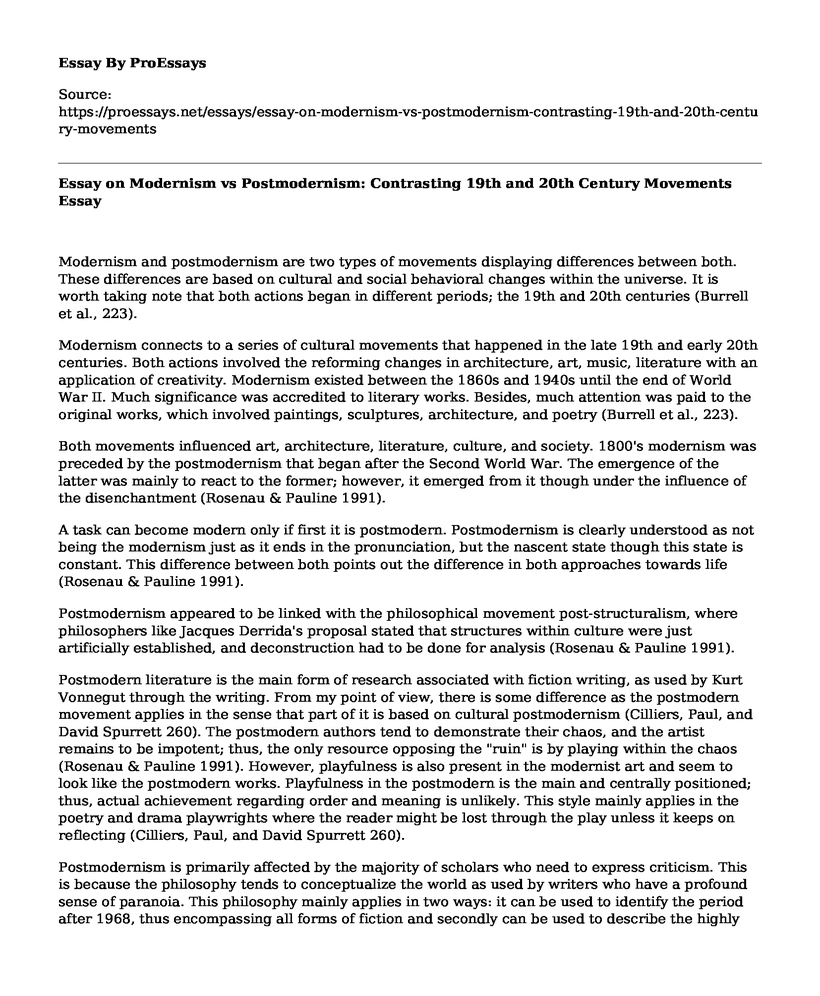Modernism and postmodernism are two types of movements displaying differences between both. These differences are based on cultural and social behavioral changes within the universe. It is worth taking note that both actions began in different periods; the 19th and 20th centuries (Burrell et al., 223).
Modernism connects to a series of cultural movements that happened in the late 19th and early 20th centuries. Both actions involved the reforming changes in architecture, art, music, literature with an application of creativity. Modernism existed between the 1860s and 1940s until the end of World War II. Much significance was accredited to literary works. Besides, much attention was paid to the original works, which involved paintings, sculptures, architecture, and poetry (Burrell et al., 223).
Both movements influenced art, architecture, literature, culture, and society. 1800's modernism was preceded by the postmodernism that began after the Second World War. The emergence of the latter was mainly to react to the former; however, it emerged from it though under the influence of the disenchantment (Rosenau & Pauline 1991).
A task can become modern only if first it is postmodern. Postmodernism is clearly understood as not being the modernism just as it ends in the pronunciation, but the nascent state though this state is constant. This difference between both points out the difference in both approaches towards life (Rosenau & Pauline 1991).
Postmodernism appeared to be linked with the philosophical movement post-structuralism, where philosophers like Jacques Derrida's proposal stated that structures within culture were just artificially established, and deconstruction had to be done for analysis (Rosenau & Pauline 1991).
Postmodern literature is the main form of research associated with fiction writing, as used by Kurt Vonnegut through the writing. From my point of view, there is some difference as the postmodern movement applies in the sense that part of it is based on cultural postmodernism (Cilliers, Paul, and David Spurrett 260). The postmodern authors tend to demonstrate their chaos, and the artist remains to be impotent; thus, the only resource opposing the "ruin" is by playing within the chaos (Rosenau & Pauline 1991). However, playfulness is also present in the modernist art and seem to look like the postmodern works. Playfulness in the postmodern is the main and centrally positioned; thus, actual achievement regarding order and meaning is unlikely. This style mainly applies in the poetry and drama playwrights where the reader might be lost through the play unless it keeps on reflecting (Cilliers, Paul, and David Spurrett 260).
Postmodernism is primarily affected by the majority of scholars who need to express criticism. This is because the philosophy tends to conceptualize the world as used by writers who have a profound sense of paranoia. This philosophy mainly applies in two ways: it can be used to identify the period after 1968, thus encompassing all forms of fiction and secondly can be used to describe the highly experimental literature as expressed by writers. Mostly the postmodernist applies in innovative writers (Rosenau & Pauline 1991).
Modernists' poets like T.S. Eliot's the author of the long poem regarded as The Waste Land. The reader is required to take an active role through the text interpretation. However, they could still make use of the technologies but always remain unchanged. Prewar works by Henry James, Joseph Conrad, among other writers, who are regarded as modernists (Burrell et al., 223).
In conclusion, there is a significant margin between modernism and postmodernism since both each engage the reader differently.
Works Cited
Rosenau, Pauline Marie. Postmodernism and the social sciences: Insights, inroads, and intrusions. Princeton University Press, 1991.
http://repository.fue.edu.eg/xmlui/bitstream/handle/123456789/2962/543.pdf?sequence=1&isAllowed=yCilliers, Paul, and David Spurrett. "Complexity and postmodernism: Understanding complex systems." South African Journal of Philosophy 18.2 (1999): 258-274.
http://www.academia.edu/download/28128125/Complexity_and_Postmodernism.pdfBurrell, Gibson. "Modernism, postmodernism, and organizational analysis 2: The contribution of Michel Foucault." Organization Studies 9.2 (1988): 221-235.
Williams, Lincoln, and Vishanthie Sewpaul. "Modernism, postmodernism, and global standards-setting." Social Work Education 23.5 (2004): 555-565.
Cite this page
Essay on Modernism vs Postmodernism: Contrasting 19th and 20th Century Movements. (2023, Jun 06). Retrieved from https://proessays.net/essays/essay-on-modernism-vs-postmodernism-contrasting-19th-and-20th-century-movements
If you are the original author of this essay and no longer wish to have it published on the ProEssays website, please click below to request its removal:
- The Motorcycle Diaries as an Example of Transnational Cinema - Essay Sample
- Compare and Contrast Essay on Cyrano de Bergerac, the Play vs. Roxanne, the Movie
- London Campus Refurbishment Project Paper Example
- Essay on Genre Theory: A Strategic Study of Films & Audience Engagement
- Essay Example on Nadeem Baig: A Pioneer of Pakistani Film Industry
- Mass Communication: Its Role in Spreading Information & Freedom - Essay Sample
- Paper Example on The Lords of Dogtown: Revolutionizing Skate & Surf in West California







